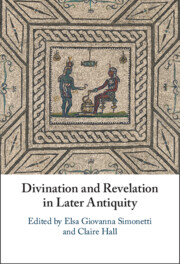Book contents
- Divination and Revelation in Later Antiquity
- Divination and Revelation in Later Antiquity
- Copyright page
- Contents
- Illustrations
- Notes on Contributors
- Acknowledgements
- Introduction
- Part I Philosophical Perspectives on Divination, Revelation, and Prophecy
- Chapter 1 Theories of Prophecy in Philo of Alexandria
- Chapter 2 The Neoplatonic Background of a Text on Prophecy Attributed to John Chrysostom
- Chapter 3 ‘Revelation’ for Christians and Pagans and Its Philosophical Allegoresis
- Chapter 4 Divination and Dialogue in Porphyry and Iamblichus
- Part II Status, Role, and Functions of Human Intermediaries
- Part III Divine Transcendence and Pragmatic Purposes
- Index
- References
Chapter 2 - The Neoplatonic Background of a Text on Prophecy Attributed to John Chrysostom
from Part I - Philosophical Perspectives on Divination, Revelation, and Prophecy
Published online by Cambridge University Press: 19 October 2023
- Divination and Revelation in Later Antiquity
- Divination and Revelation in Later Antiquity
- Copyright page
- Contents
- Illustrations
- Notes on Contributors
- Acknowledgements
- Introduction
- Part I Philosophical Perspectives on Divination, Revelation, and Prophecy
- Chapter 1 Theories of Prophecy in Philo of Alexandria
- Chapter 2 The Neoplatonic Background of a Text on Prophecy Attributed to John Chrysostom
- Chapter 3 ‘Revelation’ for Christians and Pagans and Its Philosophical Allegoresis
- Chapter 4 Divination and Dialogue in Porphyry and Iamblichus
- Part II Status, Role, and Functions of Human Intermediaries
- Part III Divine Transcendence and Pragmatic Purposes
- Index
- References
Summary
This chapter draws attention to a little-known text attributed to John Chrysostom, which has so far not aroused the interest of specialists in ancient divination and prophecy: the prologue to the commentary on the Book of Jeremiah, which nevertheless enjoyed a certain popularity in the Byzantine world. The prologue exposes a classification of forms of prophecy that has no notable parallel in patristic literature. A significant parallel can be established instead with the Neoplatonic theory of divination, as set forth for example in Iamblichus’ Response to Porphyry (De mysteriis). This parallel concerns in particular the hierarchy of the forms of predictive knowledge, as well as the relationship between demonic and natural prophecy/divination. An English translation and a commentary of the fragment concerning the prophecy is given.
- Type
- Chapter
- Information
- Divination and Revelation in Later Antiquity , pp. 32 - 48Publisher: Cambridge University PressPrint publication year: 2023



